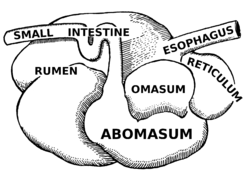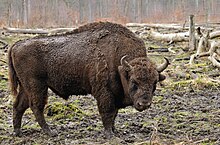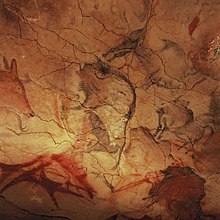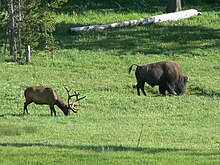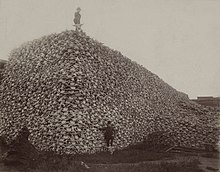Stylised illustration of a ruminant digestive system
Ruminants are mammals that are able to acquire nutrients from plant-based food by fermenting it in a specialized stomach
prior to digestion, principally through microbial actions. The process,
which takes place in the front part of the digestive system and
therefore is called foregut fermentation, typically requires the fermented ingesta (known as cud)
to be regurgitated and chewed again. The process of rechewing the cud
to further break down plant matter and stimulate digestion is called rumination. The word "ruminant" comes from the Latin ruminare, which means "to chew over again".
The roughly 200 species of living ruminants include both domestic and wild species. Ruminating mammals include cattle, all domesticated and wild bovines, goats, sheep, giraffes, deer, gazelles, and antelopes. It has also been suggested that notoungulates also relied on rumination, as opposed to other atlantogenates that rely on the more typical hindgut fermentation, though this is not entirely certain.
Taxonomically, the suborder Ruminantia (also known as ruminants) is a lineage of herbivorous artiodactyls that includes the most advanced and widespread of the world's ungulates. The term 'ruminant' is not synonymous with Ruminantia. The suborder Ruminantia includes many ruminant species, but does not include tylopods and marsupials. The suborder Ruminantia includes six different families: Tragulidae, Giraffidae, Antilocapridae, Moschidae, Cervidae, and Bovidae.
Description
Different forms of the stomach in mammals. A, dog; B, Mus decumanus; C, Mus musculus; D, weasel; E, scheme of the ruminant stomach, the arrow with the dotted line showing the course taken by the food; F, human stomach. a, minor curvature; b, major curvature; c, cardiac end G, camel; H, Echidna aculeata. Cma, major curvature; Cmi, minor curvature. I, Bradypus tridactylus
Du, duodenum; MB, coecal diverticulum; **, outgrowths of duodenum; †,
reticulum; ††, rumen. A (in E and G), abomasum; Ca, cardiac division; O,
psalterium; Oe, oesophagus; P, pylorus; R (to the right in E and to the
left in G), rumen; R (to the left in E and to the right in G),
reticulum; Sc, cardiac division; Sp, pyloric division; WZ, water-cells.
(from Wiedersheim's Comparative Anatomy)
Food digestion in the simple stomach of nonruminant animals versus ruminants
The primary difference between ruminants and nonruminants is that ruminants' stomachs have four compartments:
- rumen—primary site of microbial fermentation
- reticulum
- omasum—receives chewed cud, and absorbs volatile fatty acids
- abomasum—true stomach
The first two chambers are the rumen and the reticulum. These two
compartments make up the fermentation vat, they are the major site of
microbial activity. Fermentation is crucial to digestion because it
breaks down complex carbohydrates, such as cellulose, and enables the
animal to utilize them. Microbes function best in a warm, moist,
anaerobic environment with a temperature range of 37.7 to 42.2 °C (100
to 108 °F) and a pH between 6.0 and 6.4. Without the help of microbes,
ruminants would not be able to utilize nutrients from forages. The food is mixed with saliva and separates into layers of solid and liquid material. Solids clump together to form the cud or bolus.
The cud is then regurgitated and chewed to completely mix it with
saliva and to break down the particle size. Smaller particle size
allows for increased nutrient absorption. Fiber, especially cellulose and hemicellulose, is primarily broken down in these chambers by microbes (mostly bacteria, as well as some protozoa, fungi, and yeast) into the three volatile fatty acids (VFAs): acetic acid, propionic acid, and butyric acid. Protein and nonstructural carbohydrate (pectin, sugars, and starches)
are also fermented. Saliva is very important because it provides liquid
for the microbial population, recirculates nitrogen and minerals, and
acts as a buffer for the rumen pH. The type of feed the animal consumes affects the amount of saliva that is produced.
Though the rumen and reticulum have different names, they have
very similar tissue layers and textures, making it difficult to visually
separate them. They also perform similar tasks. Together, these
chambers are called the reticulorumen. The degraded digesta, which is
now in the lower liquid part of the reticulorumen, then passes into the
next chamber, the omasum. This chamber controls what is able to pass
into the abomasum. It keeps the particle size as small as possible in
order to pass into the abomasum. The omasum also absorbs volatile fatty
acids and ammonia.
After this, the digesta is moved to the true stomach, the
abomasum. This is the gastric compartment of the ruminant stomach. The
abomasum is the direct equivalent of the monogastric
stomach, and digesta is digested here in much the same way. This
compartment releases acids and enzymes that further digest the material
passing through. This is also where the ruminant digests the microbes
produced in the rumen. Digesta is finally moved into the small intestine,
where the digestion and absorption of nutrients occurs. The small
intestine is the main site of nutrient absorption. The surface area of
the digesta is greatly increased here because of the villi that are in
the small intestine. This increased surface area allows for greater
nutrient absorption. Microbes produced in the reticulorumen are also
digested in the small intestine. After the small intestine is the large
intestine. The major roles here are breaking down mainly fiber by
fermentation with microbes, absorption of water (ions and minerals) and
other fermented products, and also expelling waste. Fermentation continues in the large intestine in the same way as in the reticulorumen.
Only small amounts of glucose
are absorbed from dietary carbohydrates. Most dietary carbohydrates are
fermented into VFAs in the rumen. The glucose needed as energy for the
brain and for lactose
and milk fat in milk production, as well as other uses, comes from
nonsugar sources, such as the VFA propionate, glycerol, lactate, and
protein. The VFA propionate is used for around 70% of the glucose and glycogen produced and protein for another 20% (50% under starvation conditions).
Classification and taxonomy
Hofmann
and Stewart divided ruminants into three major categories based on
their feed type and feeding habits: concentrate selectors, intermediate
types, and grass/roughage eaters, with the assumption that feeding
habits in ruminants cause morphological differences in their digestive
systems, including salivary glands, rumen size, and rumen papillae.
However, Woodall found that there is little correlation between the
fiber content of a ruminant's diet and morphological characteristics,
meaning that the categorical divisions of ruminants by Hofmann and
Stewart warrant further research.
Also, some mammals are pseudoruminants, which have a three-compartment stomach instead of four like ruminants. The Hippopotamidae (comprising hippopotami) are well-known examples. Pseudoruminants, like traditional ruminants, are foregut fermentors and most ruminate or chew cud. However, their anatomy and method of digestion differs significantly from that of a four-chambered ruminant.
Monogastric herbivores, such as rhinoceroses, horses, and rabbits, are not ruminants, as they have a simple single-chambered stomach. These hindgut fermenters digest cellulose in an enlarged cecum through the reingestion of the cecotrope.
Abundance, distribution, and domestication
Wild ruminants number at least 75 million and are native to all continents except Antarctica.
Nearly 90% of all species are found in Eurasia and Africa. Species
inhabit a wide range of climates (from tropic to arctic) and habitats
(from open plains to forests).
The population of domestic ruminants is greater than 3.5 billion,
with cattle, sheep, and goats accounting for about 95% of the total
population. Goats were domesticated in the Near East circa 8000 BC. Most other species were domesticated by 2500 BC., either in the Near East or southern Asia.
Ruminant physiology
Ruminating
animals have various physiological features that enable them to survive
in nature. One feature of ruminants is their continuously growing
teeth. During grazing, the silica content in forage
causes abrasion of the teeth. This abrasion is compensated for by
continuous tooth growth throughout the ruminant's life, as opposed to
humans or other nonruminants, whose teeth stop growing after a
particular age. Most ruminants do not have upper incisors; instead, they
have a thick dental pad to thoroughly chew plant-based food.
Another feature of ruminants is the large ruminal storage capacity that
gives them the ability to consume feed rapidly and complete the chewing
process later. This is known as rumination, which consists of the
regurgitation of feed, rechewing, resalivation, and reswallowing.
Rumination reduces particle size, which enhances microbial function and
allows the digesta to pass more easily through the digestive tract.
Rumen microbiology
Vertebrates lack the ability to hydrolyse the beta [1–4] glycosidic bond of plant cellulose due to the lack of the enzyme cellulase.
Thus, ruminants must completely depend on the microbial flora, present
in the rumen or hindgut, to digest cellulose. Digestion of food in the
rumen is primarily carried out by the rumen microflora, which contains
dense populations of several species of bacteria, protozoa, sometimes yeasts and other fungi – 1 ml of rumen is estimated to contain 10–50 billion bacteria and 1 million protozoa, as well as several yeasts and fungi.
Since the environment inside a rumen is anaerobic, most of these microbial species are obligate or facultative anaerobes that can decompose complex plant material, such as cellulose, hemicellulose, starch, and proteins.
The hydrolysis of cellulose results in sugars, which are further
fermented to acetate, lactate, propionate, butyrate, carbon dioxide, and
methane.
As bacteria conduct fermentation in the rumen, they consume about
10% of the carbon, 60% of the phosphorus, and 80% of the nitrogen that
the ruminant ingests. To reclaim these nutrients, the ruminant then digests the bacteria in the abomasum. The enzyme lysozyme has adapted to facilitate digestion of bacteria in the ruminant abomasum. Pancreatic ribonuclease also degrades bacterial RNA in the ruminant small intestine as a source of nitrogen.
During grazing, ruminants produce large amounts of saliva – estimates range from 100 to 150 litres of saliva per day for a cow. The role of saliva is to provide ample fluid for rumen fermentation and to act as a buffering agent.
Rumen fermentation produces large amounts of organic acids, thus
maintaining the appropriate pH of rumen fluids is a critical factor in
rumen fermentation. After digesta pass through the rumen, the omasum
absorbs excess fluid so that digestive enzymes and acid in the abomasum
are not diluted.
Tannin toxicity in ruminant animals
Tannins are phenolic compounds
that are commonly found in plants. Found in the leaf, bud, seed, root,
and stem tissues, tannins are widely distributed in many different
species of plants. Tannins are separated into two classes: hydrolysable
tannins and condensed tannins.
Depending on their concentration and nature, either class can have
adverse or beneficial effects. Tannins can be beneficial, having been
shown to increase milk production, wool growth, ovulation rate, and
lambing percentage, as well as reducing bloat risk and reducing internal
parasite burdens.
Tannins can be toxic to ruminants, in that they precipitate
proteins, making them unavailable for digestion, and they inhibit the
absorption of nutrients by reducing the populations of proteolytic rumen
bacteria. Very high levels of tannin intake can produce toxicity that can even cause death.
Animals that normally consume tannin-rich plants can develop defensive
mechanisms against tannins, such as the strategic deployment of lipids and extracellular polysaccharides that have a high affinity to binding to tannins.
Some ruminants (goats, deer, elk, moose) are able to consume feed high
in tannins (leaves, twigs, bark) due to the presence in their saliva of
tannin-binding proteins.
Religious importance
The Law of Moses in the Bible only allowed the eating of mammals that had cloven hooves (i.e. members of the order Artiodactyla) and "that chew the cud", a stipulation preserved to this day in Jewish dietary laws.
Other uses
The verb 'to ruminate' has been extended metaphorically to mean to ponder thoughtfully or to meditate
on some topic. Similarly, ideas may be 'chewed on' or 'digested'. 'Chew
the (one's) cud' is to reflect or meditate. In psychology, "rumination" refers to a pattern of thinking, and is unrelated to digestive physiology.
Ruminants and climate change
Methane is produced by a type of archaea, called methanogens,
as described above within the rumen, and this methane is released to
the atmosphere. The rumen is the major site of methane production in
ruminants. Methane is a strong greenhouse gas with a global warming potential of 86 compared to CO2 over a 20-year period.
In 2010, enteric fermentation accounted for 43% of the total greenhouse gas emissions from all agricultural activity in the world, 26% of the total greenhouse gas emissions from agricultural activity in the U.S., and 22% of the total U.S. methane emissions.
The meat from domestically-raised ruminants has a higher carbon
equivalent footprint than other meats or vegetarian sources of protein
based on a global meta-analysis of lifecycle assessment studies.
Methane production by meat animals, principally ruminants, is estimated
15–20% global production of methane, unless the animals were hunted in
the wild.
However, the current U.S. domestic beef and dairy cattle population is
around 90 million head, which is not much different from the peak wild
population of American Bison that primarily roamed the part of North
America that now makes up the U.S. This is estimated to have been over
60 million head in the 1700s and prior.
In addition, EPA estimates suggest bison produce more methane per head
than cattle, with modern feedlot beef cattle producing perhaps as low as
half the methane of bison per head. Therefore, it is likely that the
pre-industrialized North American wild bison herd released more total
methane into the atmosphere than the current total domesticated herd of
beef and dairy cattle.
